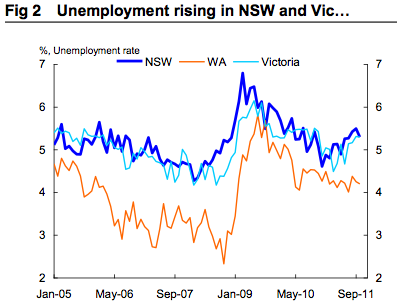
Macquarie is predicting a white collar recession in Australia, raising its forecast for unemployment to 6%:
Our economics team recently moved its unemployment forecasts to 6% on the view that Australia will experience a “white collar” recession. The team sees upside risk to 7% in the event that retail, manufacturing and tourism sectors also decide to shed staff. We summarise their analysis below.
Employment is driven by profits rather than output growth. At present, firms outside of the mining sector are struggling to boost profits as they get squeezed between rising costs and flat revenue. At the same time, the recent fall in commodity prices may point to mining profits having reached a temporary peak.
Faced with this situation, the only way in which firms can maintain or boost profits is to cut costs. And for many firms that will mean cutting employment. Consistent with this, a raft of Australian firms across a range of sectors, from manufacturing, to travel, to finance, to retail have already announced either job losses or hiring freezes.
On our assessment, the unemployment rate is likely to rise to 6.0% by mid-2012. That is a larger rise in the unemployment rate than the 51⁄2% which the Reserve Bank of Australia has currently factored into their forecasts. But while that may seem relatively mild in a historical context, it is important to understand what factors are driving this outcome.
Macquarie uses UK experience as a model for anticipating the effects in Australia:
The white collar‟ recession experienced in the UK saw a flatlining of mortgage credit post the global financial crisis, with individuals becoming increasingly reticent to take on more debt. Unsecured lending (credit cards and other personal credit) saw a sharp decline as people attempted to pay off outstanding balances. This has only just recently started to recover.
Macquarie says mortgage lending slowed sharply because the highest two income quartiles held more than three quarters of mortgage debt, not dissimilar to Australia. And it also resulted in a sharp slowing in the corporate lending to SMEs (of course SME lending in Australia is heavily related to property, so it could be expected that the two would be even more closely coupled in Australia:
Should Australia experience a deep “white collar” recession we expect a similar experience to be felt in both mortgage credit and small business credit. In our view, the Australian economy is likely to experience the tail-end of the credit cycle that started in 2008. In this sense, we are less concerned about impairment in the institutional and corporate space, however given the UK experience, we expect impairment charges to be felt by bank SME portfolios. As a result, we believe that credit costs are likely to be slightly higher than we had previously believed.
Macquarie concludes that NAB is its least preferred. But if they are right, the banking boom that has gone on for at least a decade fuelled by a housing bubble, looks to be in trouble. To put it mildly, the whole sector may be unpreferred for a while.